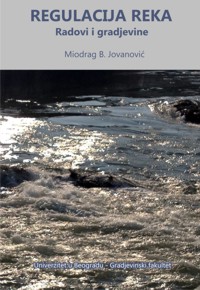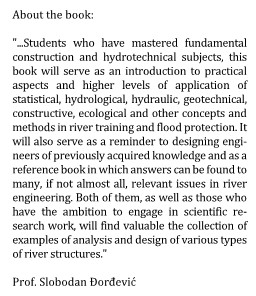Miodrag B. JOVANOVIĆ

M. Jovanović
RIVER ENGINEERING
Works and structures
(in Serbian)
Faculty of Civil Engineering
Beograd, 2022.
ISBN 978-7518-215-3
Pages: 536

https://AcadooGhostwriter.com
Download the boook [pdf]
M. Jovanović
River Engineering
River training works and structures
Contents:
1 RIVER TRAINING AS A PART OF HYDRAULIC ENGINEERING
1.1 Motives for river training
1.2 Integral approach in river training
1.3 Uncertainties and decision making
1.4 Planning of river training works
1.5 Challenges and future developments
2 RIVER TRAINING DESIGN
2.1 Introductory considerations
2.2 Design input data
- Hydrologic data
- Topographic data
- Hydraulic data
- Sediment data
- Soil data
- Ecologic data
- Other data
2.3 Design elements
- Design discharge
- Longitudinal section of the river channel
- Cross-section of the river channel
- River training structures
- River training alignment
2.4 River channel stability checkup
- Estimation of the sediment mobility
- Estimation of the general channel deformation
- Estimation of the local channel deformation
2.5 Three-level design approach
- Initial design
- Standard design
- Advanced design
2.6 Design documentation
3 RIVER TRAINING STRUCTURES
3.1 Introductory considerations
3.2 Materials in river training
- Natural materials
- Artificial materials
3.3 Revetments
- Riverbank stability
- Constructive elements of revetments
- Stone revetments
- Revetments of stacked elements
- Impact of wind induced waves
- Impact of ship induced waves
- Impact of ice
3.4 Retards
3.5 Groynes
- Types, location and function of groynes
- Length, height and spacing of groynes
- Stone groynes
- Gabion groynes
- Impact of groynes on flow and channel stability
3.6 Barriers
- Constructive elements
- Hydraulic analysis
3.7 Drop structures - cascades
- Number and height
- Gabion drop structure
- Precast concrete drop structure
- Stepped structures
3.8 Sills
- Constructive elements
- Hydraulic analysis
3.9 Special structures - vanes
3.10 Levees
- Types and functionality
- Spacing and alignment of main levees
- Constructive elements
- Impact of physical processes
- Levee: hydraulic or soil engineering structure?
4 RIVER TRAINING WORKS
4.1 Introductory considerations
4.2 Building and maintenance of structures
- Revetments
- Retards
- Groynes
- Barriers and drop structures
- Sills
- Levees
4.3 Biotechnical works
- General recommendations
- Bank protection
- Floodplain and levee protection
4.4 Artificial cutoffs
4.5 River closure and diversion
4.6 Confluence engineering
4.7 Protection of traffic infrastructure
- General and contraction scour
- Pier and abutment scour
- Culvert protection
- Sedimentation basins
4.8 Dredging
- Preparatory works
- Equipment and working technology
- Dredged material disposal
5 NATURAL RIVER TRAINING
5.1 River ecosystems
- Plant and animal environments
- River biochemical processes
- Impact of the flow regime
- Impact of the river training works
5.2 Design and technical solutions
- Basic principles
- River training structures
- Control of the channel slope
- Fish passages
5.3 Ecologic importance of floodplains
- Management of the flow regime
- Protection of the ecosystems
- Socio-economic impacts
- Floodplain restoration
6 FLOOD PROTECTION
6.1 Introductory considerations
6.2 Hydrologic uncertainty of floods
6.3 Typology of floods
6.4 Structural flood protection measures
- Passive flood protection
- Active flood protection
- Urban flood protection
- Protection against ice floods
6.5 Nonstructural flood protection measures
- Hazard and risk mapping
- Early warning systems
- Flood insurance policy
- Flood risk management
7 RIVER ENGINEERING IN SERBIA
7.1 Overview of the accomplished river training works
7.2 Important hydraulic engineering systems
Literature
Appendices
D1 - Standard sieve openings
D2 - Properties of the incoherent soils
D3 - Properties of the coherent soils
D4 - Filtration coefficient values
D5 - Floodplains roughness coefficient values
D6 - Gabion characteristics
D7 - Properties of geosynthetics
D8 - Measurement uncertainties
D9 - Error estimation in suspended sediment measurement
D10 - Coordinate system transformation
D11 - List of numerical examples
Subject index


